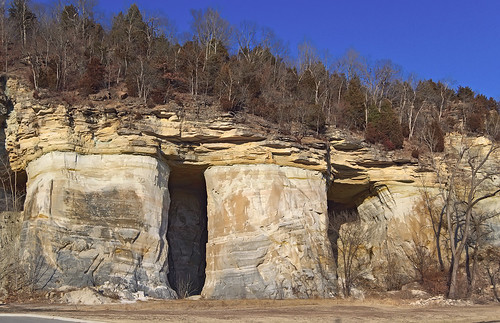
Old sandstone mines located at the extreme southwestern corner of Saint Louis County, Missouri, just 1000 feet from the Franklin County line, in Pacific Missouri. These mines are on the northern side of old U.S. Route 66 and are south of Interstate 44.
These mines are in the St. Peter Sandstone formation. There is an active quarry of this mineral just behind this ridge. This sand is of exceptional purity and is used, among other things, for manufacturing clear glass. The sandstone is also known as Ottawa Sand, after the town of Ottawa, Illinois, where it is also found. The town of Crystal City, about 30 miles to the southeast, has similar mines and is named after the glass made from this sand. According to Wikipedia:
The St. Peter Sandstone is an Ordovician formation in the Chazyan stage of the Champlainian series. This sandstone originated as a sheet of sand in clear, shallow water near the shore of a Paleozoic sea and consists of fine-to-medium-size, well-rounded quartz grains with frosted surfaces. The extent of the formation spans north-south from Minnesota to Missouri and east-west from Illinois into Nebraska and South Dakota. The type locality for the formation is St. Peter, Minnesota. In eastern Missouri the stone consists of quartz sand that is 99.44% silica.And from the Argonne National Laboratory website:
Ottawa silica sand is unique. Its rounded grains of clear colorless quartz, diamond-like in hardness, are pure silica (silicon dioxide) uncontaminated by clay, loam, iron compounds, or other foreign substances.
Glass has been locally manufactured from this sand since at least the late 19th century.
As mentioned, this sandstone is exposed in Pacific and Crystal City, Missouri, and can be seen on the roadside in many place in between. It is also exposed at the abandoned Klondike quarry in Saint Charles County, Missouri, which is now a park. Tavern Cave, located at the base of the bluffs northeast of St. Alban's, is also made of this material. There is a fresh outcropping of the sandstone at the Black Madonna Shrine, south of Eureka, Missouri: you can see it just beyond the stations of the Franciscan Chaplet.
The fresh sandstone is extremely friable, but weathering ‘case-hardens’ the stone, giving it a tough, durable patina, seen in the photo above, where the originally pure white stone turns yellow, then brown, and eventually to gray, as seen at the bottom of the cliff. This patina means that the sandstone can form huge, sheer bluffs, as seen in downtown Pacific, across the street from Saint Bridget of Kildare Church. A grotto in the cliff face is used for a Nativity scene, and a park at the top of the bluff has wonderful views of the town and surrounding countryside.
The St. Peter sandstone is quite uniform and has no bedding and almost no fossils. This means that exposed weathered sections tend to be rounded in shape and lack the stair-steps seen in most sedimentary rock outcroppings hereabouts. You can see exposures in Jefferson County and no doubt elsewhere. Very little plant life can grow on the exposed rock, and rainwater quickly runs off of the rounded surfaces, making natural outcroppings of this rock very distinctive, with unusual desert plants and animals living on it, rarely found elsewhere in Missouri.
In the photo above, the rock is overlain with Joachim Dolomite, as is the case nearly everywhere the rock is found. It is named after Joachim Creek in Jefferson County, Missouri, which in turn is named after the father of the Virgin Mary. Many caves are found in the Joachim formation, especially in Perry County, Missouri. Geologists believe that this rock was formed directly over the St. Peter Sandstone, and come from deposits in somewhat deeper water than the sandstone.


Great photo and descriptive text. Thanks!
ReplyDeletefascinating Mark, I remember driving past the mines at Crystal City many times as a child. I seem to recall that they were designated as fall out shelters during the 50s and 60s.
ReplyDelete. . . care to comment if this formation could have been laid down by the Genesis Flood 4,500 yrs ago?
ReplyDeletehttp://www.newadvent.org/cathen/04702a.htm
ReplyDelete